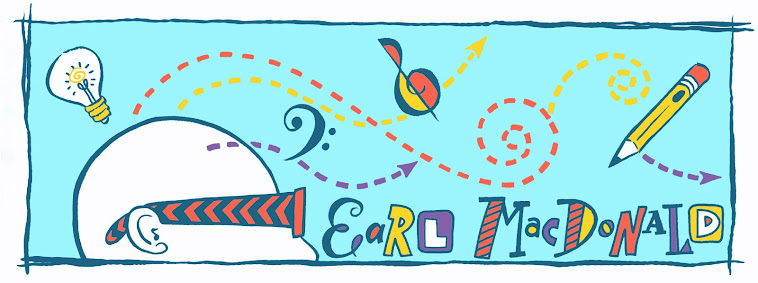I do most of my (extracurricular) listening to music in the car these days, but twice in the past week I drove home in complete silence following musical events where my head just felt overloaded with sound. (Actually, I've been musically assaulted three times this week, if you count church). The first was after adjudicating 15 middle/high school bands, and the second was following a concert by John Hollenbeck's Large Ensemble. Although the later was inspiring, it left me feeling like I was driven over by a huge, sonic truck... and even more exhausted than after 10 hours of adjudicating.
I think I like Hollenbeck's music more for what it represents than for listening pleasure. He has successfully wedded the aesthetics of jazz and contemporary classical music, to form something new. In his pre-concert master class he expressed his discomfort with the musical status quo. The notion of pushing oneself to try new things is very appealing to me. Do I aspire to write music like John? Not really --- although there are plenty of beautiful moments within his music. What I DO hope to incorporate is the mindset of questioning everything (process, form, desired outcomes... you name it), and forcing myself to experiment outside of my comfort zone.
Today's piece will be an experiment of sorts. One of John's pieces, "Perseverance" offered a good reminder of the power of unison. The main melody featured 3 tenor saxophonists and electric bass playing the same line together over a drum beat. Despite being melodically quirky, it was powerful and convincing. I decided to run with that idea.
I began with the question: If I were to write a 12-bar tune comprised of conventional jazz rhythms and typical phrase lengths, but worked exclusively with 12-tone rows, could the piece be easily distinguishable as a blues? There would be no chord symbols, the line would be played in unison (or octaves) and the piece would serve as a launch pad for free improvisation, while always adhering to the 12-bar form. So I did what any other great composer would do. I put all 12 tones into a hat, and allowed my wife to choose the pitches.
Writing rhythms was next. I then visited www.musictheory.net, where I generated a matrix. From there, I tweaked my rhythms slightly so that the total number of notes would be divisible by 12. The row and its various manifestations (prime, inversion, retrograde, retrograde inversion) would be presented 5 times.
Here's what resulted:
Does the experiment work? I guess we'll see on my next quartet gig.
With the right players, I think it will, but even if it doesn't, I
think the process has been valuable. Ever up and onward.
I think I like Hollenbeck's music more for what it represents than for listening pleasure. He has successfully wedded the aesthetics of jazz and contemporary classical music, to form something new. In his pre-concert master class he expressed his discomfort with the musical status quo. The notion of pushing oneself to try new things is very appealing to me. Do I aspire to write music like John? Not really --- although there are plenty of beautiful moments within his music. What I DO hope to incorporate is the mindset of questioning everything (process, form, desired outcomes... you name it), and forcing myself to experiment outside of my comfort zone.
Today's piece will be an experiment of sorts. One of John's pieces, "Perseverance" offered a good reminder of the power of unison. The main melody featured 3 tenor saxophonists and electric bass playing the same line together over a drum beat. Despite being melodically quirky, it was powerful and convincing. I decided to run with that idea.
I began with the question: If I were to write a 12-bar tune comprised of conventional jazz rhythms and typical phrase lengths, but worked exclusively with 12-tone rows, could the piece be easily distinguishable as a blues? There would be no chord symbols, the line would be played in unison (or octaves) and the piece would serve as a launch pad for free improvisation, while always adhering to the 12-bar form. So I did what any other great composer would do. I put all 12 tones into a hat, and allowed my wife to choose the pitches.
Writing rhythms was next. I then visited www.musictheory.net, where I generated a matrix. From there, I tweaked my rhythms slightly so that the total number of notes would be divisible by 12. The row and its various manifestations (prime, inversion, retrograde, retrograde inversion) would be presented 5 times.
Here's what resulted:


Early twentieth century serialism jazz? Pretty crazy stuff. I want to hear the recording!!!
ReplyDelete